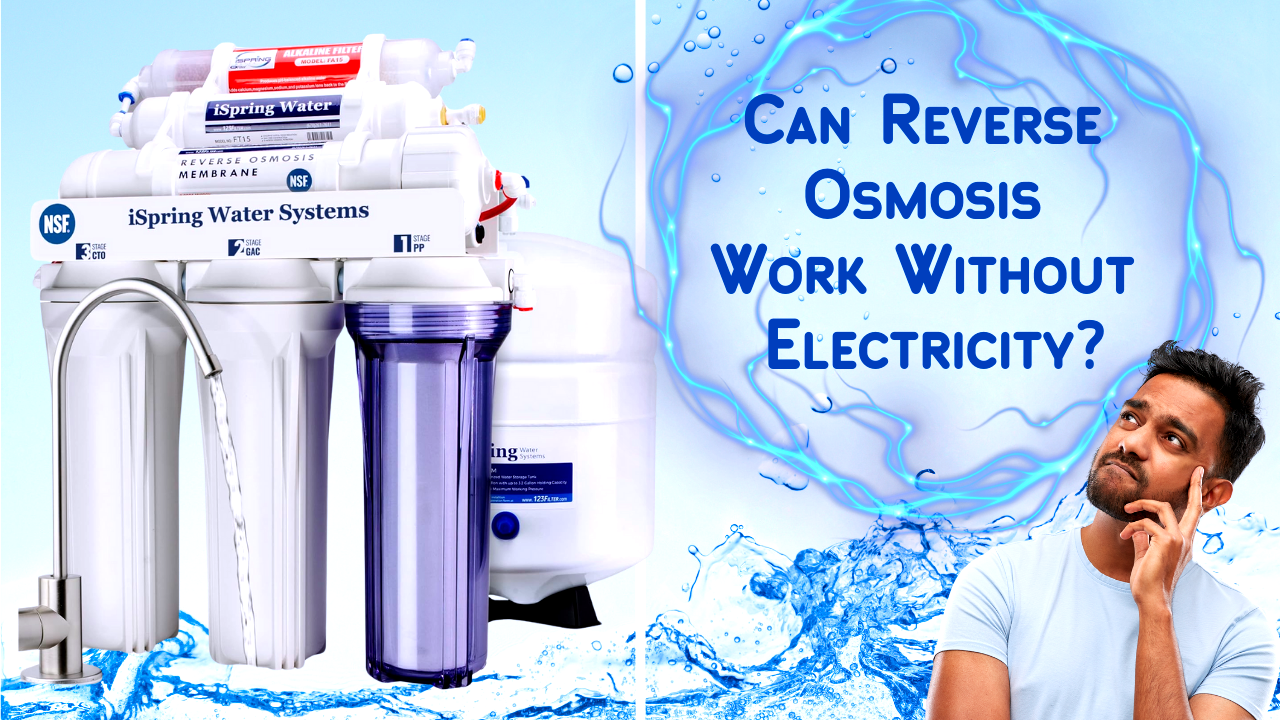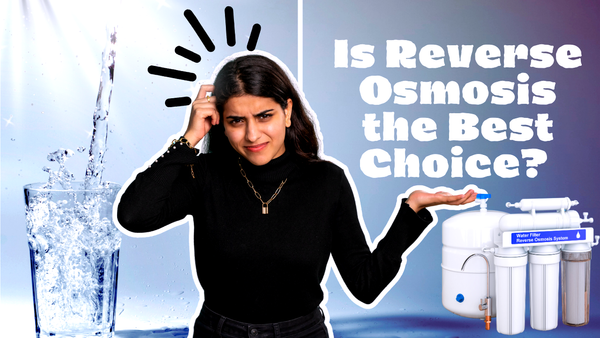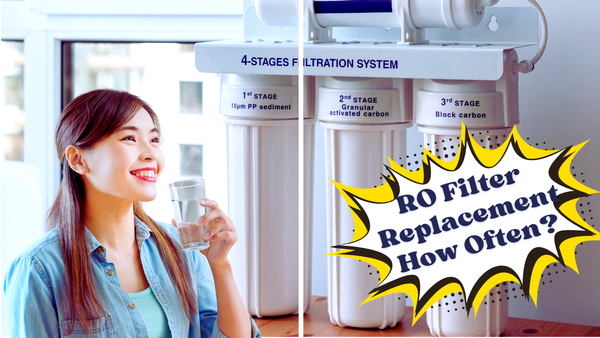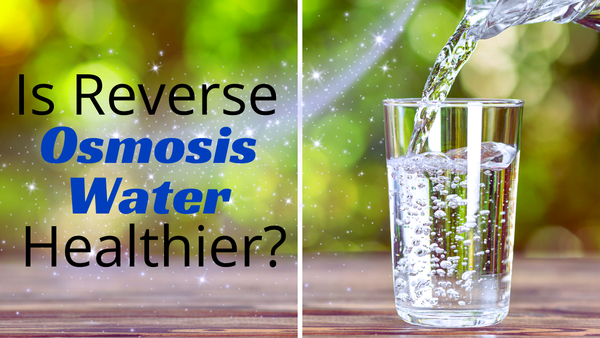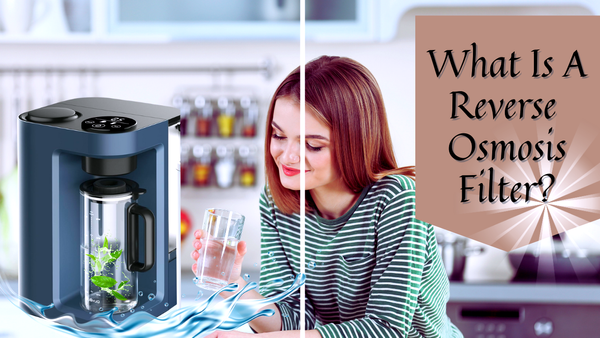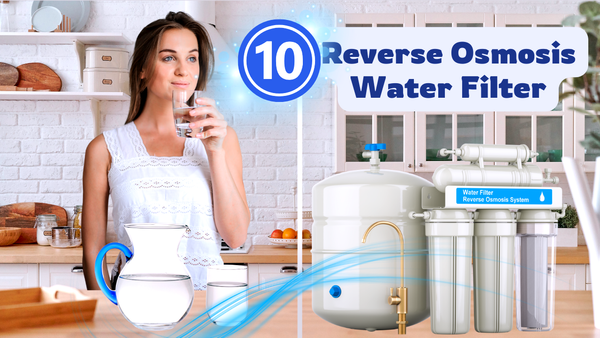Key Takeaways:
- Reverse osmosis systems typically require electricity to function efficiently.
- Non-electric reverse osmosis systems exist but have limitations.
- Understanding the mechanics of reverse osmosis helps choose the right system for your needs.
Reverse osmosis (RO) is a water filtration process that uses pressure to push water molecules through a semi-permeable membrane. It’s very effective at producing pure water, so it’s used in both residential and commercial applications.
Reverse osmosis water filtration is known for its purity and removal of contaminants, but it is also expensive and removes beneficial minerals from the water. The question often asked is "Can reverse osmosis work without electricity?" To answer that, we need to examine the mechanics of reverse osmosis systems, the different components, and their functions.

How Reverse Osmosis Works
Reverse osmosis systems apply pressure to the water and force it through a reverse osmosis membrane. This semi-permeable membrane allows water molecules to pass through and blocks nearly all contaminants, including dissolved salts, bacteria, and other impurities. The result is clean water to drink and use.
It starts with pre-filters that remove larger particles and chlorine that can damage the RO membrane. The water then goes through the RO membrane, where the actual filtration occurs. Then the filtered water is stored in a tank or delivered to a tap.
Components of a Reverse Osmosis System
A typical reverse osmosis system consists of several key components: pre-filters, the RO membrane, a storage tank, and post-filters. Pre-filters, such as activated carbon filters, remove chlorine and other large particles. The RO membrane is the heart of the system, where the actual filtration takes place. The storage tank holds the purified water until it is needed, and post-filters provide additional purification before the water reaches the tap.
A reverse osmosis unit is essential in both residential and commercial settings, significantly improving water quality and connecting to appliances like refrigerators and ice machines. Each component plays a crucial role in ensuring the system’s efficiency and effectiveness. Understanding these components helps in assessing whether a reverse osmosis system can function without electricity.
The Role of Electricity in Reverse Osmosis Systems

Reverse osmosis filtration is a highly effective method for providing clean drinking water, particularly in areas lacking safe water. Electricity is primarily used in reverse osmosis systems to power the electric pump, which increases water pressure. Higher pressure is essential for forcing water through the RO membrane, especially in systems that deal with low incoming line pressure or require higher output.
Without electricity, the system relies solely on the natural water pressure from the incoming line. While this can be sufficient in some cases, it often results in slower filtration rates and reduced efficiency. Therefore, electricity is a critical component for optimal performance in most reverse osmosis systems.
Non-Electric Reverse Osmosis Systems
Non-electric reverse osmosis systems do exist, but they come with limitations. These systems rely entirely on the incoming water pressure to drive the filtration process. While this can work in areas with high water pressure, it is less effective in regions with low pressure.
Additionally, osmosis water systems have significant environmental and economic drawbacks, particularly the substantial amount of water wasted during the filtration process, which can be many times greater than the water produced for consumption. Non-electric systems are often used in portable or emergency applications where electricity is not available. However, they typically produce less purified water and may not remove as many contaminants as their electric counterparts.
Advantages of Electric Reverse Osmosis Systems
Electric reverse osmosis systems offer several advantages over non-electric models. The primary benefit is increased water pressure, which enhances the filtration process and results in higher output and better water quality. Electric systems can also include features like automatic shut-off valves and pressure gauges, which improve convenience and efficiency.
RO water effectively removes various contaminants, including salts, bacteria, and volatile chemicals, which enhances its quality for both drinking and industrial applications. Additionally, electric systems are more effective at removing a wider range of contaminants, including dissolved salts and other impurities. This makes them a better choice for households and businesses that require high-quality purified water.
Limitations of Non-Electric Reverse Osmosis Systems
While non-electric reverse osmosis systems can function without electricity, they have several limitations. The most significant drawback is reduced water pressure, which leads to slower filtration rates and lower output. This can be problematic in households with high water usage or areas with low incoming line pressure. RO membranes play a crucial role in system performance and maintenance, as they are essential in preventing scaling, chemical attack, and fouling, thereby ensuring high water quality and efficient filtration.
Non-electric systems also tend to have shorter lifespans and may require more frequent maintenance. The lack of an electric pump means that the system relies entirely on natural water pressure, which can vary and affect the system’s performance.
Case Study: Non-Electric RO System in Rural Areas

In rural areas where electricity is scarce, non-electric reverse osmosis systems can provide a viable solution for clean drinking water. For example, a community in a remote village implemented a non-electric RO system to filter their groundwater. While the system provided purified water, it struggled with low water pressure, resulting in slower filtration rates.
Reverse osmosis water filtration is effective in purifying water by removing contaminants, but it also has disadvantages such as high costs, water wastage, and the removal of beneficial minerals. This makes it suitable primarily for areas lacking safe drinking water or where high levels of specific contaminants are present. Despite these challenges, the community benefited from having access to cleaner water. This case study highlights the potential of non-electric RO systems in specific scenarios, although they may not be as efficient as electric models.
The Importance of Water Pressure
Water pressure is a critical factor in the effectiveness of reverse osmosis systems. Higher pressure forces water through the RO membrane more efficiently, resulting in better filtration and higher output. In areas with low water pressure, an electric pump is often necessary to achieve optimal performance.
Without sufficient pressure, the system may not remove all contaminants, leading to lower water quality. Therefore, understanding the importance of water pressure is essential when considering a non-electric reverse osmosis system.
Enhancing Non-Electric RO Systems
While non-electric reverse osmosis systems have limitations, there are ways to enhance their performance. One approach is to use a water softener to reduce the hardness of the incoming water, which can improve the efficiency of the RO membrane. Additionally, regular maintenance and cleaning of the system can help prevent premature fouling and ensure consistent performance.
Another effective method is to install an under-sink RO unit, which is designed to connect to appliances like refrigerators and ice makers. These units maintain appropriate water pressure, fit neatly under the counter, and provide RO-filtered water for improved taste and safety.
Another option is to install a booster pump, which can increase water pressure without relying on electricity. These pumps are often powered by alternative energy sources, such as solar panels, making them a viable
Comparing Electric and Non-Electric RO Systems

When comparing electric and non-electric reverse osmosis systems, several factors come into play. Electric systems offer higher efficiency, better water quality, and additional features like automatic shut-off valves. However, they require a reliable power source and may have higher upfront and operating costs.
When considering an RO unit, practical aspects such as lifespan, maintenance requirements, and installation options are crucial. Connecting the RO unit to other appliances, understanding its water usage, and comparing it with other filtration methods can provide a comprehensive understanding of its applications.
Non-electric systems, on the other hand, are more suitable for areas with limited or no access to electricity. They are often more affordable and easier to install but may not provide the same level of filtration and output as electric models.
Choosing the Right RO System for Your Needs
Selecting the right reverse osmosis system depends on various factors, including water quality, pressure, and availability of electricity. For households with high water usage and access to a reliable power source, an electric RO system is often the best choice. These systems provide superior filtration and higher output, ensuring a consistent supply of purified water.
In contrast, non-electric systems are better suited for portable or emergency applications, as well as areas with limited electricity. While they may not offer the same level of performance as electric models, they can still provide clean drinking water in challenging conditions.
Installation and Maintenance of RO Systems

Proper installation and maintenance are crucial for the optimal performance of reverse osmosis systems. Electric systems require a power source and may involve more complex installation procedures, including wiring and plumbing. Non-electric systems are generally easier to install but still require careful attention to ensure proper functioning.
Regular maintenance, such as replacing filters and cleaning the RO membrane, is essential for both electric and non-electric systems. This helps prevent fouling and ensures consistent water quality. Understanding the specific maintenance requirements of your system can help prolong its lifespan and improve its efficiency.
The Role of Pre-Filters in RO Systems
Pre-filters play a vital role in reverse osmosis systems by removing larger particles and chlorine from the incoming water. This protects the RO membrane from damage and improves the overall efficiency of the system. Common pre-filters include sediment filters and activated carbon filters, which target different types of contaminants.
Regularly replacing pre-filters is essential to maintain the system's performance. Clogged or worn-out pre-filters can reduce water pressure and affect the filtration process, leading to lower water quality and output.
The Function of Post-Filters in RO Systems
Post-filters provide additional purification after the water has passed through the RO membrane. These filters target any remaining contaminants and improve the taste and odor of the purified water. Common post-filters include activated carbon filters and UV sterilizers, which can remove chlorine, bacteria, and other impurities.
Like pre-filters, post-filters require regular replacement to ensure optimal performance. Understanding the specific needs of your system can help you choose the right post-filters and maintain consistent water quality.
The Impact of Water Quality on RO Systems

Water quality is a significant factor in the performance of reverse osmosis systems. High levels of dissolved salts, chlorine, and other contaminants can affect the efficiency of the RO membrane and reduce the system's lifespan. Regular testing of your water quality can help identify potential issues and determine the best filtration solution.
In areas with poor water quality, additional pre-treatment steps, such as water softeners or additional pre-filters, may be necessary to protect the RO membrane and improve the system's performance.
The Benefits of RO Systems for Drinking Water
Reverse osmosis systems provide numerous benefits for drinking water, including the removal of nearly all contaminants, improved taste, and better overall water quality. These systems are highly effective at removing dissolved salts, chlorine, bacteria, and other impurities, making them a popular choice for households and businesses.
In addition to providing clean drinking water, RO systems can also reduce the need for bottled water, leading to cost savings and environmental benefits. Understanding the advantages of RO systems can help you make an informed decision about your water filtration needs.
The Environmental Impact of RO Systems

While reverse osmosis systems offer significant benefits for water quality, they also have environmental considerations. The filtration process produces wastewater, which can be a concern in areas with limited water resources. However, many modern RO systems are designed to minimize wastewater and improve efficiency.
Additionally, using an RO system can reduce the reliance on bottled water, which has a significant environmental impact due to plastic waste and transportation emissions. By choosing an efficient RO system and practicing water conservation, you can enjoy the benefits of purified water while minimizing your environmental footprint.
The Cost of RO Systems
The cost of reverse osmosis systems can vary widely depending on the type, size, and features of the system. Electric systems tend to be more expensive due to the additional components and higher efficiency, while non-electric systems are generally more affordable.
When considering the cost of an RO system, it's essential to factor in both the initial investment and ongoing maintenance expenses. Regular filter replacements, membrane cleaning, and potential repairs can add to the overall cost of the system. Understanding these costs can help you choose a system that fits your budget and meets your water filtration needs.
The Lifespan of RO Systems
The lifespan of a reverse osmosis water filter system depends on various factors, including the quality of the components, water quality, and maintenance practices. High-quality systems with regular maintenance can last for many years, providing consistent water quality and performance.
Regularly replacing filters, cleaning the RO membrane, and addressing any issues promptly can help extend the lifespan of your system. Understanding the specific maintenance requirements and following the manufacturer's recommendations can ensure that your RO system continues to provide purified water for years to come.
The Future of Reverse Osmosis Technology

Reverse osmosis technology is continuously improving and getting more efficient and effective. Innovations like more durable membranes, energy-efficient pumps, and advanced filtration techniques are making RO systems more accessible and sustainable.
As technology progresses we can expect to see even more efficient and eco-friendly RO systems that provide high-quality purified water with minimal waste and energy consumption. Stay updated with the latest developments to choose the right system for you and ride the wave of water filtration innovation.
Summary
Reverse osmosis systems can provide purified water by removing almost all contaminants through a semi-permeable membrane. Electricity is usually required for optimal performance but non-electric systems can work in certain situations but with limitations. Knowing the components, water pressure and maintenance requirements of RO systems will help you choose the right system for you and get consistent water quality. To keep up with the latest water filter tips and offers, subscribe to our newsletter today!
FAQ
Can RO work without electricity?
Yes, RO can work without electricity but it relies entirely on the incoming water pressure. Non-electric systems are less efficient and may not remove as many contaminants as electric models.
What are the components of a RO system?
An RO system consists of pre-filters, an RO membrane, a storage tank, and post-filters. Each component is important in the filtration process and overall system performance.
How often should I replace the filters in my RO system?
Filter replacement frequency depends on the system and water quality. Pre-filters should be replaced every 6-12 months, RO membrane and post-filters every 2-3 years. Regular maintenance is key to optimal performance.
